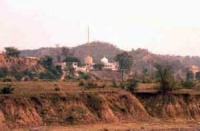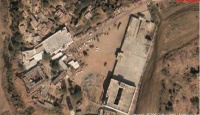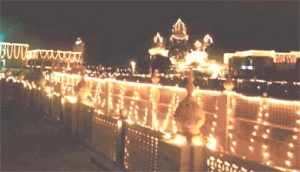Gurudwara Nada Sahib: Difference between revisions
No edit summary |
No edit summary |
||
| Line 3: | Line 3: | ||
NADA SAHIB, [[Gurdwara]] Patshahi Dasvin, situated at the end of a narrow spur of soft sandy rocks of the Sivalik foothills, on the left bank of the river Ghaggar, about 10 km east of [[Chandigarh]] (30°44'N, 76°46'E), commemorates the visit of [[Guru Gobind Singh]], who halted here while travelling from Paonta Sahib to [[Anandpur]] after the battle of Bharigam in 1688. One Nadu Shah Lubana of the adjoining village served him and his followers with food and milk. The place remained obscure until one Bhai Motha Singh, who belonged to a village near by, discovered the sacred spot and raised a platform to perpetuate the memory of the Guru's visit. Nothing more is known of the devout Motha Singh nor of the date of the establishment of the Manji Sahib, except that the shrine was under the Dharmarth Board of Patiala and East Punjab States Union in 1948 and was taken over by the | NADA SAHIB, [[Gurdwara]] Patshahi Dasvin, situated at the end of a narrow spur of soft sandy rocks of the Sivalik foothills, on the left bank of the river Ghaggar, about 10 km east of [[Chandigarh]] (30°44'N, 76°46'E), commemorates the visit of [[Guru Gobind Singh]], who halted here while travelling from Paonta Sahib to [[Anandpur]] after the battle of Bharigam in 1688. One Nadu Shah Lubana of the adjoining village served him and his followers with food and milk. The place remained obscure until one Bhai Motha Singh, who belonged to a village near by, discovered the sacred spot and raised a platform to perpetuate the memory of the Guru's visit. Nothing more is known of the devout Motha Singh nor of the date of the establishment of the Manji Sahib, except that the shrine was under the Dharmarth Board of Patiala and East Punjab States Union in 1948 and was taken over by the | ||
Shiromani Gurdwara Parbandhak Committee after the merger of the state with the [[Punjab]] in 1956. Since then several new buildings have been constructed. The original Manji Sahib has been replaced by a doublestoreyed domed structure, with a large rectangular meeting hall [[Image:Nada sahib.JPG|thumb|200px|left|Nada Sahib]]adjacent to it. A spacious brickpaved courtyard separates these buildings from the complex comprising the Guru ka Larigar and rooms for pilgrims. The holy flag flies atop a 105feet high staff on one side of the courtyard, near the site of the old shrine. The full moon day every month is celebrated as a festive occasion attended by a large number of people from the surrounding villages and towns. Religious gatherings and community meals take place. The management is now entrusted to a local committee which also administers [[Gurdwara Manji Sahib]] at Pinjore. | Shiromani Gurdwara Parbandhak Committee after the merger of the state with the [[Punjab]] in 1956. Since then several new buildings have been constructed. The original Manji Sahib has been replaced by a doublestoreyed domed structure, with a large rectangular meeting hall [[Image:Nada sahib.JPG|thumb|200px|left|Nada Sahib]]adjacent to it. A spacious brickpaved courtyard separates these buildings from the complex comprising the Guru ka Larigar and rooms for pilgrims. The holy flag flies atop a 105feet high staff on one side of the courtyard, near the site of the old shrine. The full moon day every month is celebrated as a festive occasion attended by a large number of people from the surrounding villages and towns. Religious gatherings and community meals take place. The management is now entrusted to a local committee which also administers [[Gurdwara Manji Sahib]] at Pinjore. | ||
[[Image:Nadasahibduringggsceremony.jpg|yhumb|right|300px|Gurudwara Sahib during SGGS ceremony]] | |||
[[Category:Gurdwaras In Haryana]] | [[Category:Gurdwaras In Haryana]] | ||
Revision as of 04:58, 12 August 2007
NADA SAHIB, Gurdwara Patshahi Dasvin, situated at the end of a narrow spur of soft sandy rocks of the Sivalik foothills, on the left bank of the river Ghaggar, about 10 km east of Chandigarh (30°44'N, 76°46'E), commemorates the visit of Guru Gobind Singh, who halted here while travelling from Paonta Sahib to Anandpur after the battle of Bharigam in 1688. One Nadu Shah Lubana of the adjoining village served him and his followers with food and milk. The place remained obscure until one Bhai Motha Singh, who belonged to a village near by, discovered the sacred spot and raised a platform to perpetuate the memory of the Guru's visit. Nothing more is known of the devout Motha Singh nor of the date of the establishment of the Manji Sahib, except that the shrine was under the Dharmarth Board of Patiala and East Punjab States Union in 1948 and was taken over by the
Shiromani Gurdwara Parbandhak Committee after the merger of the state with the Punjab in 1956. Since then several new buildings have been constructed. The original Manji Sahib has been replaced by a doublestoreyed domed structure, with a large rectangular meeting hall
adjacent to it. A spacious brickpaved courtyard separates these buildings from the complex comprising the Guru ka Larigar and rooms for pilgrims. The holy flag flies atop a 105feet high staff on one side of the courtyard, near the site of the old shrine. The full moon day every month is celebrated as a festive occasion attended by a large number of people from the surrounding villages and towns. Religious gatherings and community meals take place. The management is now entrusted to a local committee which also administers Gurdwara Manji Sahib at Pinjore.



